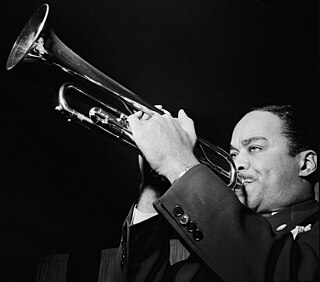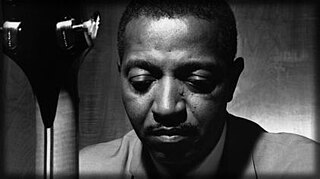
William James "Count" Basie was an American jazz pianist, organist, bandleader, and composer. In 1935, he formed the Count Basie Orchestra, and in 1936 took them to Chicago for a long engagement and their first recording. He led the group for almost 50 years, creating innovations like the use of two "split" tenor saxophones, emphasizing the rhythm section, riffing with a big band, using arrangers to broaden their sound, his minimalist piano style, and others. Many musicians came to prominence under his direction, including the tenor saxophonists Lester Young and Herschel Evans, the guitarist Freddie Green, trumpeters Buck Clayton and Harry "Sweets" Edison, plunger trombonist Al Grey, and singers Jimmy Rushing, Helen Humes, Thelma Carpenter, and Joe Williams. As a composer, Basie is known for writing such jazz standards as Blue and Sentimental, Jumpin' at the Woodside and One O'Clock Jump.

Carlos Wesley "Don" Byas was an American jazz tenor saxophonist, associated with swing and bebop. He played with Count Basie, Duke Ellington, Art Blakey, and Dizzy Gillespie, among others, and also led his own band. He lived in Europe for the last 26 years of his life.

Frank Wellington Wess was an American jazz saxophonist and flutist. In addition to his extensive solo work, Wess is remembered for his time in Count Basie's band from the early 1950s into the 1960s. Critic Scott Yanow described him as one of the premier proteges of Lester Young, and a leading jazz flutist of his era—using the latter instrument to bring new colors to Basie's music.
Paul Quinichette was an American jazz tenor saxophonist. He was known as the "Vice President" or "Vice Prez" for his emulation of the breathy style of Lester Young, whose nickname was "The President", or simply "Prez". Young called Quinichette "Lady Q".

Wilbur Dorsey "Buck" Clayton was an American jazz trumpeter who was a member of Count Basie's orchestra. His principal influence was Louis Armstrong, first hearing the record "Confessin' That I Love You" as he passed by a shop window.

The Count Basie Orchestra is a 16- to 18-piece big band, one of the most prominent jazz performing groups of the swing era, founded by Count Basie in 1935 and recording regularly from 1936. Despite a brief disbandment at the beginning of the 1950s, the band survived long past the big band era itself and the death of Basie in 1984. It continues under the direction of trumpeter Scotty Barnhart.

Frederick William Green was an American swing jazz guitarist who played rhythm guitar with the Count Basie Orchestra for almost fifty years.
Walter Sylvester Page was an American jazz multi-instrumentalist and bandleader, best known for his groundbreaking work as a double bass player with Walter Page's Blue Devils and the Count Basie Orchestra.

Herschel "Tex" Evans was an American tenor saxophonist who was a member of the Count Basie Orchestra. He also worked with Lionel Hampton and Buck Clayton. He is also known for starting his cousin Joe McQueen's interest in the saxophone. Joe McQueen, living until 2019 at age 100, may well have been the last surviving person to have known Herschel during his lifetime.

"One O'Clock Jump" is a jazz standard; a 12-bar blues instrumental, written by Count Basie in 1937.

Lady Day: The Complete Billie Holiday on Columbia 1933–1944 is a 10-CD box set compiling the complete known studio master recordings, plus alternate takes, of Billie Holiday during the time period indicated, released in 2001 on Columbia/Legacy, CXK 85470. Designed like an album of 78s, the medium in which these recordings initially appeared, the 10.5" × 12" box includes 230 tracks, a 116-page booklet with extensive photos, a song list, discography, essays by Michael Brooks, Gary Giddins, and Farah Jasmine Griffin, and an insert of appreciations for Holiday from a diversity of figures including Tony Bennett, Elvis Costello, Marianne Faithfull, B.B. King, Abbey Lincoln, Jill Scott, and Lucinda Williams. At the 44th Grammy Awards on February 27, 2002, the box set won the Grammy Award for Best Historical Album of the previous year.
Lester Rallingston "Shad" Collins was an American jazz trumpet player, composer and arranger, who played in several leading bands between the 1930s and 1950s, including those led by Chick Webb, Benny Carter, Count Basie, Lester Young, Cab Calloway and Sam "The Man" Taylor.
"Lester Leaps In" is a jazz standard originally recorded by Count Basie's Kansas City Seven in 1939. The composition, credited to the group's tenor saxophone player Lester Young, is a contrafact based on the chord progression of "I Got Rhythm", and serves as a vehicle for interweaving solos by Young and Basie.

The Original American Decca Recordings is a 1992 compilation 3-CD set of sessions led by jazz bandleader Count Basie recorded for the Decca label between 1937 and 1939.

Count Basie Story is a double album by pianist, composer and bandleader Count Basie featuring tracks originally performed by his orchestra in the 1930s and 1940s rerecorded in 1960 as a celebration of its 25th anniversary and first released on the Roulette label. Selections from the 2-LP set were also released as Roulette's The Best of Basie in 1962 and The Best of Basie Vol. 2 in 1964. The album was rereleased with bonus tracks in 2004 to commemorate Basie's 100th birthday.

Boogie Woogie is a compilation album containing four 10-inch, 78 rpm records of boogie-woogie music. The songs on the album were recorded over a period of three years from 1936 to 1939, then released in 1941 on this compilation album by Columbia Records (C44). Artists featured on the album include Harry James, Count Basie, Big Joe Turner, and the three prominent boogie-woogie pianists of the time, Albert Ammons, Pete Johnson, and Meade Lux Lewis.
"This Year's Kisses" is a popular song written in 1936 by Irving Berlin for the musical film On the Avenue (1937) and introduced by Alice Faye. Popular recordings in 1937 were by Benny Goodman, Hal Kemp, Shep Fields and by Teddy Wilson with Billie Holiday.

Jumpin' at the Woodside, subtitled A Buck Clayton Jam Session, is an album by trumpeter Buck Clayton which was recorded between 1953 and 1956 and released on the Columbia label.

For Basie is an album by American jazz saxophonist Paul Quinichette featuring tracks recorded in 1957 and released on the Prestige label.

Basie Reunion is an album by Count Basie Orchestra members led by jazz saxophonist Paul Quinichette featuring tracks recorded in 1958 and released on the Prestige label.














